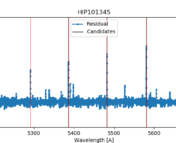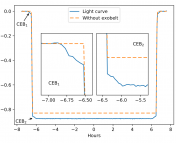Title: The Breakthrough Listen Search For Intelligent Life Near the Galactic Center I
Authors: Vishal Gajjar, Karen I. Perez, Andrew P. V. Siemion, Griffin Foster, Bryan Brzycki, Shami Chatterjee, Yuhong Chen, James M. Cordes, Steve Croft, Daniel Czech, David DeBoer, Julia DeMarines, Jamie Drew, Michael Gowanlock, Howard Isaacson, Brian C. Lacki, Matt Lebofsky, David H. E. MacMahon, Ian S. Morrison, Cherry Ng, Imke de Pater, Danny C. Price, Sofia Z. Sheikh, Akshay Suresh, Claire Webb, S. Pete Worden
First Author’s Institution: Berkeley SETI research center at the University of California, Berkeley, CA, USA
Status: Accepted for publication in AJ [closed access]
Looking out into the night sky, almost everyone has probably wondered whether or not we are alone in our vast universe. While many would argue that we are not, we still have yet to find any proof of this. So, in the past decade, we have begun building instruments and funding projects to try to figure this exact question out. In January of 2016, a new initiative known as The Breakthrough Listen Initiative (BLI) was awarded $100 million USD to look for direct signs of intelligent life through technosignatures. BLI will look at ~1 million stars, look at 100 nearby galaxies, and take a detailed look at the center of our galaxy for possible signs of intelligent life. Today’s authors present the first results (although still very much preliminary) on the search for intelligent life at the center of our galaxy. While they don’t find any aliens yet, they guide us through why we should be looking at the center of our galaxy and what we should be looking for.
Why the galactic center?
The galactic center (GC) is home to the highest number density of stars, and our line of sight (LOS) to the galactic center has the highest number of stars along it out of any of our possible LOSs. Think about us looking away from the galactic center. Since we already reside towards the outer edge of the galaxy at a distance of 8.5kpc, we would basically be looking out into a sea of nothing! Thus, looking towards the center offers the largest number of stars for observations.
The GC is home to many different types of cataclysmic events such as supernovae and flares from magnetars. This brings into question whether planetary systems would be able to successfully form. Today’s authors model the fraction of stars with habitable planets at a given distance from the GC. As seen in the below figure (Fig 1), this fraction is actually highest at the GC! Since our galaxy formed inside out (meaning that things formed at the GC first and then started to form at distances farther from the GC), the planets at the GC have had the most time to form. So even though there might be cataclysmic events affecting some of them, there is both more stuff to form planets out of and more time for these planets to become habitable as compared with the portion of the sky that the earth lies in.
So we’ve decided on the galactic center, but what are we looking for and what are we going to use to look for it?
For their search, the authors use two different radio telescopes: 1. the Green Bank Telescope (GBT) in West Virginia for a higher frequency range of 3.9 to 93 GHz and 2. the Parkes Observatory in Australia for a lower frequency range of 0.7 to 3.8 GHz. Radio waves are ideal for these types of observations as they are both the cheapest to create and can easily penetrate through the atmosphere of their host planet and of the earth due to their long wavelengths.
There are two possible types of signals the authors could search for: 1. signals that are created for detection by another civilization and 2. signals which arise accidentally as by-products of a given civilization’s technology. The author’s of today’s paper focus on the first type of signal since it will be stronger than type 2 signals emitted by another planet and easier to differentiate from type 2 signals created on our own planet.
They first focus on very narrowband signals similar to the ones shown in the below figure (Fig 2). The signal would occupy one or two frequency channels, and would also drift in a plot of (frequency, time) due to the doppler effect between the motion of Earth and the motion of the technosignature’s planet. To differentiate narrowband signals produced on earth from those at or along the LOS to the GC, each ON pointing of a given telescope (towards the region of interest) was accompanied by an OFF pointing that was one beam width away. A signal that appears in both an ON and OFF pointing can then be attributed to noise on Earth.
They also look for broadband signals similar to those we have seen from pulsars. However, in order to differentiate them from pulsars, they focus on three artificially dispersed signals shown in the below figure (Fig 3).
And they find… nothing (yet)
While the total time allotted for radio observations of the GC center using the GBT and the Parkes Observatory are 280 and 352 hours, respectively, this paper only presents observations from the first 11.2 hours with the GBT and the first 7 hours with the Parkes Observatory. That’s only ~2% of the total observing time! The search is also further constrained in that the detection pipeline is not yet perfect, and the authors limit the types of doppler effects that they search over due to computational costs. Thus, with only ~20 hours of data, the authors do not detect any narrowband or broadband signals that might indicate the presence of an intelligent society.
However, they are able to place constraints on the types of signals that a civilization at the GC could produce. They can rule out broadband, artificial signals occurring on a timescale shorter than 4 hours in the 3.9 to 8 GHz frequency range. They are also able to place limits on the Equivalent Isotropic Radiated Power (EIRP), which is the power emitted isotropically (in all directions) by a transmitter (the object producing the signal we are trying to detect). Their limits are really unique in that they are covering previously unexplored frequency bands!
AND there is still some cool auxiliary science!
Even though they don’t find any signs of life yet, the galactic center is full of radio sources which they were able to search for within their data. They are able to detect over 600 pulses from the magnetar SGR J1745−2900.
And so, while there were no aliens today, the author’s developed a detailed method for looking for them, and still have ~610 observing hours left to go…
Astrobite edited by Zili Shen
Featured image credit: Breakthrough Listen / Danielle Futselaar





Start a major search for the alien spacecraft coming to earth, aka UFOS.